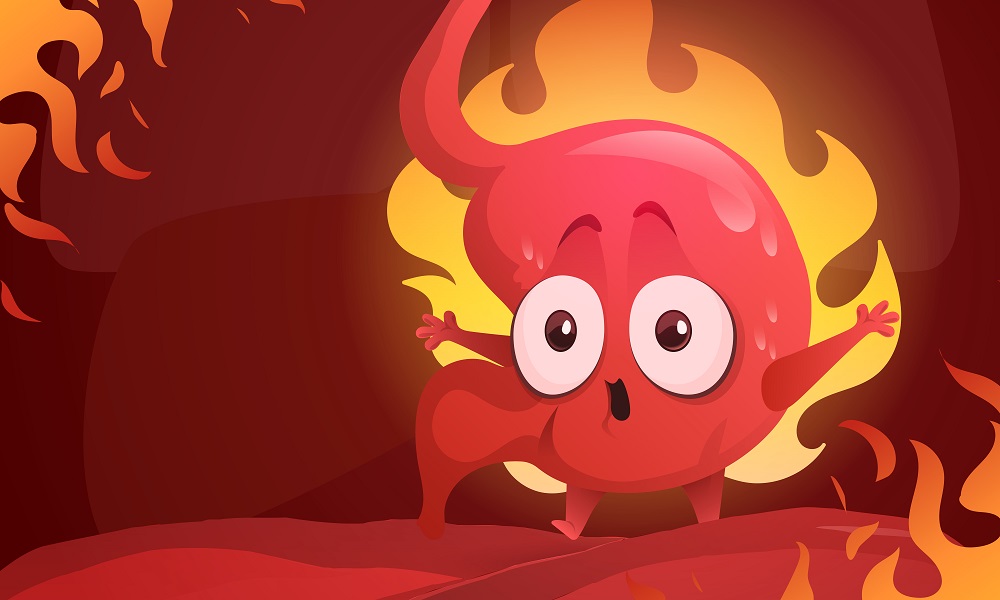
Stages of illness is the end result of behaviors that are inadequate to maintain our full health.
Ayurveda is a medicine that educates us positively on our way of living, thinking and evolving in a healthy and serene environment to stay healthy.
It is therefore above all a preventive medicine before being a healing medicine and its effectiveness is no longer to be proven.
It educates precisely on nutrition, attitude and beneficial behaviors to follow according to our personal Ayurvedic constitution called prakriti.
Ayurveda and stages of illness
The disease can be detected and treated at any stage. Treatment and remission are, of course, more effective in the early stages of the disease.
The disease process begins with disturbances in the balance of the doshas (or biophysiological humors) vata, pitta and kapha.
Temporary imbalances are common and completely normal, but serious problems arise if the state of imbalance is not corrected quickly.
In the normal course of events, vata, pitta and kapha go through cycles of change in three stages: accumulation, provocation or aggravation, and pacification.
Imbalances examples
Pitta, for example, begins to show and accumulate in late spring. This is brought on or aggravated during the hot summer months, and Pitta dosha naturally subsides when the weather cools in the fall.
If the increase in the dosha is not appeased naturally by a change of season, it undergoes other changes and illness may result.
If a person with a vata-predominant constitution experiences some degree of increased vata in the fall due to cool, dry, windy weather, but returns to normal soon after, the disease will not develop. not.
With the right lifestyle and diet, everyone can restore their balance, for example by eating moist, warming foods and by dressing warmly in windy weather, for the person of Vata constitution.
If the aggravated state of vata persists, vata will move into the general circulation and into the deep connective tissue, where it will generate pathological changes.
The disease will then develop.
From the imbalance that persists over time we enter the phase of disorder, and disorder is disease.
Illness is like the growth of the fetus in the mother’s womb. It originates in the body and is known as samprapti or pathogenesis, literally “the birth of pain”.
What is the illness process according to ayurveda?
The accumulation phase

Due to various causes, such as diet, weather, seasons, emotions, etc., the doshas begin to accumulate in their respective sites: vata in the colon, pitta in the intestines, and kapha in the stomach. . This is the easiest step to dealing with any emerging health issues. The imbalance can be felt at this stage by diagnosing your pulse.
The accumulation of Vata can result in constipation, abdominal distension or gas in the colon. Pitta buildup can be felt as warmth around the navel area and can be seen as a slightly yellowish discoloration in the whites of the eyes or dark yellow colored urine. The person will be very hungry and will crave sweets and sugar.
The accumulated kapha leads to feelings of heaviness, lethargy and loss of appetite.
At this stage, the individual is still healthy and when a dosha begins to become unbalanced, the body is intelligent and develops a distaste for the causative factor and needs to feed on opposite qualities.
This can be done through food with qualities opposite to the dosha, lifestyle, management of thoughts to restore balance.
For example, if you ate ice cream three days in a row and the kapha builds up, you won’t want to eat ice cream anymore. Instead, your body will crave spicy foods to burn off excess kapha and counteract it. We must relearn how to listen to the body and its wisdom to avoid increasing the causes of our imbalances.
Aggravation illness’phase
The accumulated dosha continues to accumulate in its own site. The stomach fills with kapha, the intestines fill with pitta, or the colon overflows with vata.
These accumulated doshas can then move from their sites. Kapha can rise in the lungs, pitta in the stomach and gallbladder, and vata can rise in the flanks.
You can also feel this phase.
An example:
If you eat too much food with kapha properties on Saturday evening, the next morning you may feel full and feel the need to fast or eat light. But if that same day you are invited and you eat a lot again, the next day you may have a cough or a feeling of congestion in the lungs. For what? Because kapha starts moving up the body.
Too much pitta in the second stage can cause heartburn or acid indigestion, and even nausea.
Vata can cause pain in the flanks or middle of the back, or even shortness of breath.
According to Ayurveda, the disease process can be treated at any stage, but specific treatments are needed for advanced stages. In these first two steps, one can reverse the process by using common sense and applying the principle of opposing qualities. And by taking some home remedies. But once the disease process has moved beyond the gastrointestinal tract and entered the third phase, it is no longer under its own control and qualified medical help is needed.
Diffusion illness’phase
The next stages of illness is diffusion. The dosha begins to spread from its place of origin, overflowing into the bloodstream and the general circulation of the body,. It is”searching” for a place to enter. Here, the disease process has progressed to the point where eliminating the causative factor will not suffice. A panchakarma, purification treatment (or similar cleansing regimen) is necessary in order to direct the doshas into their respective sites in the gastrointestinal tract so that they can be excreted out of the body.
Ama, Agni and the disease process
The biological fire of the body, which governs the transformation of matter into energy, is of thirteen main types. The central fire, called Jatharagni, governs digestion and assimilation of food.

The other agnis (the fire component in cells, tissues and organs) carry out the local process of digestion and nutrition. When agni is strong and healthy, then whatever a person eats, the system digests, assimilates and absorbs it. Then removes impurities.
But when the doshas are aggravated due to bad diet, unhealthy lifestyle or negative emotions, they first affect agni, which becomes imbalance. When agni becomes weakened or disturbed, food is not properly digested.
Undigested and unabsorbed food particles accumulate in the gastrointestinal tract and other subtle sites of the body and turn into a toxic. This sticky, foul-smelling substance is called Ama. (Ama can also be formed by bacterial invasion and cell metabolism waste.) In the third stage (“spread”) of the disease process, ama overflows its site of origin to other bodily channels. It spreads in blood vessels, capillaries and lymphatics, and clogs the channels and cell membranes.
When these ama molecules clog the channels, the cellular intelligence (prana) that constantly circulates between cells gets blocked. And some cells become isolated. An isolated cell is a solitary cell, and a solitary cell is a confused cell.
Pathological changes begin to occur. But the root cause of pathological changes is the movement of these ama molecules. So the ama must be eliminated from the body by panchakarma or other means.

Deposit or infiltration of illness
The aggravated dosha enters a weak or defective organ, tissue or system. This is the consequence due to previous trauma, genetic predisposition, accumulated emotional stress, repressed emotions or other factors.
Smoking cigarettes, for example, creates weakness in the lungs. Eating too much sugar creates weakness in the pancreas and blood tissues, and so on.
The newly arrived and aggravated dosha confuses the cellular intelligence of the weakest tissue and overwhelms it. And it is altering its normal qualities and functions.
Aggravated dosha suppresses the normal qualities of tissue. It combines with it, creating an altered state, altering its structure and function. In this way, the “seeds” of the disease begin to sprout.
So far, the disease has not appeared on the surface, but it can be detected by a qualified doctor.
An alert person may feel subtle changes in the body. If the condition is not interrupted at this stage, it will break out as a disease in its own right.
Ilness’manifestation
In this stage of illness, qualitative changes become apparent. Signs and symptoms of real disease appear on the surface; the person becomes ill. Whether in the lungs, kidneys, liver, joints, heart, brain, or anywhere, the germs of disease germinate and begin to manifest in the area of defective tissue.
Cellular deformation leading to structural distortion
Now the pathological process is fully developed and the disease fully manifested.
Structural changes occur and complications in organs, tissues or systems become evident. It is also at this stage that the disease, fully developed, is therefore the most difficult to treat.
In the fifth stage of illness, for example, when the aggravated pitta dosha invades the stomach wall, it may manifest as an ulcer. But in the sixth stage, the pitta will perforate the ulcer and cause bleeding, or it may cause a tumor.
The function begins to be disturbed in the fifth stage, but here the structure of the tissue is affected, as well as the surrounding tissues and systems.
Obviously, the treatment and the return to balance is much easier in the early stages.
This is why prevention is so strongly emphasized in Ayurveda. It is much more effective to treat the disease at the seed stage, before it germinates and develops.
Health and disease are processes. All the stages of illness has been reached.
Disease is a process of abnormal movement of the doshas, while health is a process of normal functioning of the doshas.
Conclusion
A wise person understands that the normal rhythm and quality of the process can be restored by changing diet and lifestyle (stress management, yoga and meditation, healthier eating and mind habits), and avoiding the etiological factors that cause the disease.
The more attentive you are to how your mind, body, and emotions respond to changing circumstances; the more aware you are of your constitution and the instant choices you can make to stay healthy. The less chance you create of getting sick.
Interested to become Ayurveda Therapist? Have a look here or here (in french)
